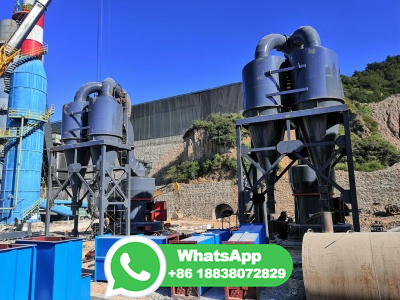
Traditional coaltomethanol (Process 1) suffers from high CO 2 emission due to mismatch of H/C ratio between coal and methanol. A pulverized coal gasificationintegrated SOEC process (Process 2) has been investigated, the watergasshift unit is avoided and a simplified acid gas removal process is implemented to replace traditional acid gas ...
WhatsApp: +86 18203695377
Process Economics Program Report 282 METHANOL TO GASOLINE (December 2011) Rising petroleum prices have once again focused global attention on using coal to manufacture liquid transportation fuels that can displace petroleumderived gasoline and diesel.
WhatsApp: +86 18203695377
The current global capacity of methanol production is 164 Mton·a º1 (year 2021), with an annual increase of 10% projected for the next decade [10]. Traditionally, methanol synthesis is fed by fossilbased syngas, which comes either from steam reforming of natural gas or from coal gasifi cation [11]. However, sustainable syngas
WhatsApp: +86 18203695377
The coalbased process releases about kg CO 2 /kg methanol, and the natural gasbased process releases about kg CO 2 /kg methanol (Galindo Cifre and Badr, 2007, Rivarolo et al., 2016). Production of methanol from renewable sources reduces the intensity of fossil fuels as the main feed and also helps in mitigating CO 2 emissions ...
WhatsApp: +86 18203695377
The biomasstomethanol process is more utilization efficient and environmentfriendly as its water consumption and carbon dioxide emission were only t/t methanol and t/t methanol produced, respectively, which were found to be much smaller than the coaltomethanol process. Pellegrini et al. studied the economic viability of a ...
WhatsApp: +86 18203695377
Economic analyses from a number of sources (using 1973 dollars) indicate that at a 12% discounted cash flow rate methanol could be produced for between 0·13 and 0·20/gal ( 2·02 and 3·08/million Btu), depending on coal cost, gasification and methanol conversion scheme, location of plant, and other factors. The current domestic energy ...
WhatsApp: +86 18203695377
The LCA results for the BAU process, methanol from syngas derived from ... Future costs of hydrogen from water electrolysis will reduce the gap with fossil methanol, making CO 2based methanol economically appealing when externalities are considered. In contrast, replacing CO 2 captured from coal plants or natural gas plants, which lead ...
WhatsApp: +86 18203695377
But the retirement process of coal will slow down this year, and the low price of coal will make the CTL process more costeffective than other sustainable energy sources [38]. And many researchers have shown that the synfuels produced through the FischerTropsch process are equally efficient as crude oils and a clean source of energy.
WhatsApp: +86 18203695377
Methanol is a clean fuel and an important feedstock for the petrochemical industry. Conventionally, the coaltomethanol process generates a substantial amount of CO2 emissions with a low yield of ...
WhatsApp: +86 18203695377
A process for methanol production from natural gas containing 3080% CO 2 was analyzed. For this design a partial feed hydrogenation process is followed by a combined reforming operation and H 2 injection in order to obtain syngas of appropriate quality. A methanol plant of 400,000 t/y that uses a Lurgi reactor for the synthesis reaction, was ...
WhatsApp: +86 18203695377
The LCA results for the BAU process, methanol from syngas derived from ... Future costs of hydrogen from water electrolysis will reduce the gap with fossil methanol, making CO 2based methanol economically appealing when externalities are considered. In contrast, replacing CO 2 captured from coal plants or natural gas plants, which lead ...
WhatsApp: +86 18203695377
Methanol is primarily converted to formaldehyde, which is widely used in many areas, especially polymers. The conversion entails oxidation: 2 CH 3 OH + O 2 → 2 CH 2 O + 2 H 2 O. Acetic acid can be produced from methanol. The Cativa process converts methanol into acetic acid. Methanol and isobutene are combined to give methyl tertbutyl ether ...
WhatsApp: +86 18203695377
A different type of ICL process involving methanol is the gasification of coal followed by conversion to methanol and subsequent conversion of methanol to a marketable gasoline product. A 100,000 ton/year MTG process plant was started in China's Jincheng, Shanxi province, in 2009, as part of a CTL demonstration complex.
WhatsApp: +86 18203695377
In Fig. 1, the box diagram for the methanol production via natural gas reforming along with direct hydrogenation of CO 2 captured from the power plant flue gas is shown, which is the proposed process in this study. Six operating steps are considered for this purpose: 1) Capturing CO 2 from the flue gas.. 2) Steammethane (natural gas) reforming. 3) Compression of CO 2.
WhatsApp: +86 18203695377
How is Methanol Produced? While today we produce methanol from natural gas, methanol can also be made from renewable sources, such as renewable natural gas, biomass and green hydrogen combined with recycled carbon dioxide. Methanex is studying the feasibility of converting our existing assets to produce lowercarbon intensity methanol. We are committed to pursuing opportunities [.]
WhatsApp: +86 18203695377
Methanol fuel is an alternative biofuel for internal combustion and other engines, either in combination with gasoline or independently. Methanol (C H 3 O H) is less expensive to produce sustainably than ethanol fuel, although it produces more toxic effects than ethanol and has lower energy density than gasoline. Methanol is safer for the environment than gasoline, is an antifreeze agent ...
WhatsApp: +86 18203695377
Methanol synthesis: This Minireview describes the mechanism of methanol synthesis, and considers a way of synthesizing methanol from sustainable, nonfossil hydrogen. This combines electrolysis of water using solar energy, combined with CO 2 garnered from a coal power plant. It covers the synthesis of traditional CZA (Cu−Zn−Al) based ...
WhatsApp: +86 18203695377
The CTM process diagram (NETL, 2015) of a conventional coalbased gasification (CG) process is shown in Fig. 2. Milled coal and water are mixed to make slurry. Coal slurry is gasified at high temperature and high pressure to produce crude syngas, which contains mainly H 2 and CO as well as small amounts of other gases, such as CO 2, H 2 S, and ...
WhatsApp: +86 18203695377
Methanol is an important feedstock of chemical engineering and energy source, and it is mainly produced by coal route in China. The coaltomethanol suffers from serious CO 2 emissions and carbon resource waste since water gas shift is involved in this process to increase hydrogen content of syngas for meeting methanol synthesis. A novel coaltomethanol process integrated with cokeoven gas ...
WhatsApp: +86 18203695377
For the whole process, coal gasification temperature can reach nearly 1300 °C, and the reforming of methane is over 600 °C while the watergas shift reaction should be keep at 650 °C. ... With the increase of methane/coal, methanol concentration in the product increased firstly to the peak of % when methane/coal ratio is then ...
WhatsApp: +86 18203695377
LinzDonawitz gas is currently used as a heat source for the steelmaking process by combustion, which is a conventional pathway. ... primary source could reduce especially global warming, fossil resource scarcity, and water consumption than using hard coal or natural gas by %, %, and %, leading to an ...
WhatsApp: +86 18203695377
In this report we review entrained bed coal gasification technology using the Shell Coal Gasification Process (SCGP), integrated with the ICI/Synetix Low Pressure Methanol (LPM) process for the production of 5,000 MTPD of chemical grade methanol. Economics are then compared with the economics of producing 5000 metric tons per day of methanol ...
WhatsApp: +86 18203695377
The coaltomethanol process can be divided into four major cost areas: coal purchase, coal gasification, gas preparation, and methanol synthesis. The contribution to the plantgate cost was estimated for each area except for coal purchase by dividing the plant capital and operating costs among the areas and calculating a product price for each.
WhatsApp: +86 18203695377
Nowadays, methanol is industrially produced by carbon monoxide (CO) hydrogenation over copperzinc catalysts. The mixture of CO and hydrogen, also called syngas, which is used for methanol synthesis, usually contains significant amount of CO 2. The methanol synthesis technology from CO 2 using heterogeneous catalysts has reached relatively high ...
WhatsApp: +86 18203695377
OVERVIEW OF COALTOLIQUIDS: A HISTORICAL PERSPECTIVE iii ACRONYMS AND ABBREVIATIONS bbl Barrel BP British Petroleum bpd Barrels per day CAER University of Kentucky Center for Applied Energy Research CCLP Chevron Coal Liquefaction Process CCS Carbon capture and storage CO Carbon monoxide CO 2 Carbon dioxide CPI OPECConsumer Price Index
WhatsApp: +86 18203695377
Methanol can be used to make a gasoline product. The process uses a special zeolite catalyst with pore size such that molecules up to C10 can get out of the catalyst. Larger molecules cannot be made with this process; therefore, a product is made with no carbon molecules greater than C10, which boils in the gasoline range.
WhatsApp: +86 18203695377
Methanol production process from natural gas: ... reported methanol production costs using coal and natural gas within the range of 396469 USD/t for coal and 311345 USD/t for natural gas (NG at ...
WhatsApp: +86 18203695377
The main purpose of this work is to examine the technoeconomics and environmental assessment of the Solid Recovered Fuel and Lignite to methanol pathway. Methanol is produced by gasifying the solid fuels to carbon monoxide and hydrogen and then reacting to produce methanol under pressure during the methanol synthesis process. The data obtained from the partners is used to adapt this study for ...
WhatsApp: +86 18203695377
The Liquid Phase Methanol (LPMEOH ) Demonstration Project at Kingsport, Tennessee, is a million cooperative agreement between the Department of Energy (DOE) and Air Products Liquid Phase Conversion Company, (the Partnership) to produce methanol from coalderived synthesis gas (syngas).
WhatsApp: +86 18203695377
By comparison, the conventional industrial process for making methanol from methane requires temperatures of 1000°C (1832°F) and extreme high pressure. ... The broad process of converting coal into methanol consists of conversion of coal to synthesis (syngas) gas, syngas cleaning and conditioning, syngas to methanol conversion, and methanol ...
WhatsApp: +86 18203695377
Title: Getting Methane From Coal Level: Secondary Day/Time: Objective: Synthetic crude oil can be produced from coal through coal liquification, and coal can be converted to natural gas (methane) through a coal gasification process. This gas produced from coal, could be made into gasoline for cars, kerosene for jet planes, or mixed with natural ...
WhatsApp: +86 18203695377
gas or coal). • The lifecycle emissions from current methanol production and use are around gigatonnes (Gt) CO 2 per annum (about 10% of total chemical sector emissions). • Methanol production has nearly doubled in the past decade, with a large share of that growth being in China. Under current trends, production could rise to
WhatsApp: +86 18203695377
Chemicals from Coal. For centuries, people have been making useful products by performing chemical reactions with natural substances — everything from manufacturing glass from sand to converting wood to methanol, acetic acid, and charcoal. Throughout the years, coal has been an important natural resource in the manufacture of chemical products.
WhatsApp: +86 18203695377